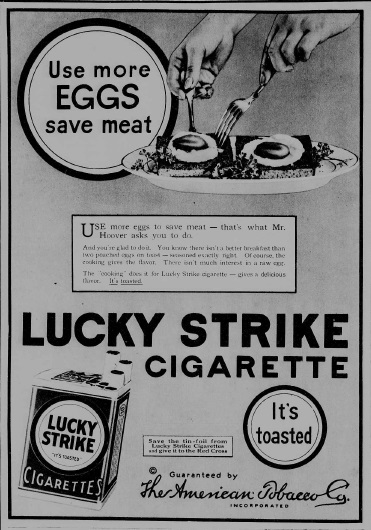Use More Eggs Save Meat
Up In Smoke
Prior to the war, most tobacco was consumed via pipes. Pipes were seen as sophiscated where cigarettes were seen as juvenile or even effeminate. Those who did smoke cigarettes were viewed as dandies, or they were immigrants from parts far from being true American. Pipes, however, were difficult to use in trench warfare. They were hard to keep lit, and repeated use of lighters at night was dangerous in an era where sharpshooters at night were looking for targets. They also were fragile, the worst being the German kind, which were finely crafted by delicate ceramic. Cigarettes were quick to light, left no apparatus after it was consumed and were portable. They quickly came into high demand on all sides. Each army gave tobacco to the troops, and it soon became a form of currency on the lines. The British considered two cigarettes the value of a haircut, for instance.
Cigarettes, like every other soldier friendly commodity, advertised heavily for the war. Companies marketed brands such as Paul Maul, Lucky Strike, Camel, Murad, Bull Durham and Chesterfields heavily pro-war, and it changed society. Cigarette drives were made of various independent organizations including the Red Cross and the Y. M. C. A., whom just before the war was opposed to any tobacco use because of the health effects. During the war, however, they went to great lenghts to get the boys their smokes. The Y. M. C. A. even trained a service dog to carry cartons to the trenches, they name him "Dobut".
Many of the ads were of a high professional level, being iconical works of art themselves in an era obsessed with media presentation. Lucky Strike ads in particular produced high color paintings depicting young, healthy men and women. Murad changed their images weekly and ran hundreds of images of combat and charging into the fray with a cigarettes. Whereas men would go into the Army to fight the Kaiser, they came back smokers. After the war, the spread of tobacco reached so far that for the first time, women were marketed to. One post war culture shift was the social acceptance of women smokers in public.
